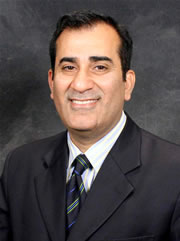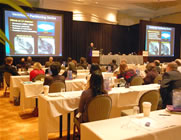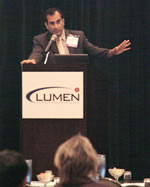 |

|
 |

Sameer Mehta, MD,
FACC, MBA, is Voluntary Associate Professor of Medicine
at University of Miami Miller School of Medicine,
President of the Indo American Society of Interventional Cardiology,
editor
of the Cath Lab Digest STEMI Interventions section and author
of the Textbook
of STEMI Interventions.
Dr. Mehta is considered a pioneer in the specialty
of STEMI intervention, the treatment of heart attacks using
percutaneous coronary interventions (PCI). He has done groundbreaking
work on shortening door-to-balloon times for STEMI interventions
and is the course director for LUMEN,
the Annual Symposium on Optimal Treatment for Acute
MI, now in its tenth year. The 2011
LUMEN course is being held on February
24-26 in Miami, Florida. In this interview, Dr. Mehta
discusses the
upcoming LUMEN symposium which this year is featuring the
transradial (wrist) approach to treating STEMI.
A
complete list of educational offerings for the transradial
approach
can be found on the Transradial
Training Courses page in Angioplasty.Org's Radial
Access Center. |
|

Sameer
Mehta, MD, FACC, MBA |
| "I
think door-to-balloon times, as challenging as they may
appear to some people,
are simply the low hanging fruit of STEMI intervention.
I truly believe that the greater challenges are legislation
and patient education." |
|
Q: This is the
10th year of the LUMEN course. This is the first year you are
featuring the transradial approach. Why now?
Dr. Mehta: Well
I'm convinced, mainly because of my international work in
STEMI intervention, that we are grossly underpenetrated in
our application
of transradial STEMI intervention. I think theres too much
resistance, too much lack of awareness and comfort level
among interventional cardiologists to try the transradial
approach
for the rushed door-to-balloon environment that exists in
STEMI intervention. If you look around the world, particularly
in
parts of Asia, as well as in Europe, there is not much hesitation.
People actually have a very high level of skills and comfort
level in performing their procedures from the transradial
route.
One can always argue which is better: going transfemoral
gives
you more options, but the patient comfort, the decrease
in bleeding and early ambulation are clearly the reasons
to
go transradial. |
To further induce the U.S. interventional
cardiologists, I thought LUMEN would be a perfect venue to not
only have a dedicated workshop, but also to bring in absolute
world experts who are recognized for their vast experience and
have them demonstrate the techniques, the safety, the application,
the methodology, as well as several case presentations to share
with everybody.
For example, we have Dr. Tejas Patel of Ahmedabad, India conducting
one of the workshops. He conducts the annual
TRICO workshop,
and it is to
his credit that he was the father for most of us in this effort
and I think he'll contribute in a very valuable fashion to
the meeting. |
|
 |
| "I'm
convinced that the absolutely perfect combination for a lot
of these
patients
is going to be transradial procedures performed with bivalirudin.
You have the access site which reduces bleeding, as well as a
drug which is known to reduce bleeding..." |
|
Q:
You mentioned lack of bleeding complications in the transradial
approach. Can you speak as to how this is important specifically
in the treatment of heart attack?
Dr. Mehta: We understand that there is a direct correlation between bleeding
during the STEMI or even the PCI intervention and long-term mortality. So this
is not a small matter to be dismissed as a nuisance or something. Not only do
the patients do poorly early on, but there is even an impact on their long-term
mortality. So it's something extremely critical and I think the control of bleeding
is vital.
I'm convinced that the absolutely perfect combination for
a lot of these patients is going to be transradial procedures
performed with bivalirudin.
You have the access site which reduces bleeding, as well as a drug which is
known to reduce bleeding on the basis of the data from the
HORIZONS AMI trial. The
combination probably represents the most optimal way of performing a STEMI
intervention. |
Transradial is not going to be for every case, but I think the
penetration should increase. The physicians that are performing
STEMI interventions should feel comfortable with both techniques.
They should also understand that there has to be some very careful
triage of patients. Not everybody is going to be suitable for the
transradial route. A patient presenting with cardiogenic shock
will probably require a right-heart catheterization, will often
require an intra-aortic balloon pump or the Impella device. So
there has to be a very mature balance in applying these technologies
and this is precisely the purpose of bringing in world experts
who can share their own experiences.
Q: The treatment of heart attack specifically involves being able
to do this very quickly, and reduce the door-to-balloon time. Some
cardiologists in the U.S., who work primarily with femoral access,
say that transradial takes longer and would present a delay.
Dr. Mehta: I happen to fall in exactly this group. I long have
had exactly the same doubts, the same apprehensions, the feeling
that you are adding another level of difficulty, another complex
variable to an already challenging situation where every minute
counts. But we have also learned from the experience of others
that once you reach a threshold of expertise, you probably become
quite comfortable in doing the procedure without any significant
increase in the procedure time. I'll be the first one to humbly
acknowledge that there is a genuine apprehension, not unfounded,
but I think it is also timely for us to adopt this technology.
Q: Many radial operators use
the transradial approach as their default access site ("Radial First").
Does this apply to treating STEMI?
Dr. Mehta: I am not yet convinced of this. I tend to believe that
transfemoral should be the preferable technique. I think we are
much more used to using it. Our awareness and expertise has been
there for many years that provide you greater options for some
patients who may have a more difficult clinical presentation and
yet I think that one should know both techniques. The sad part
is that there are a number of interventional cardiologists who
are unable to perform transradial and that is precisely the purpose
of mandating and forcing the theme that I have put into this particular
symposium.
Q: That being said, is there a specific type of patient where
the transradial approach to STEMI is preferable?
Dr. Mehta: I think anybody with lack of access, with severe peripheral
vascular disease, is obviously that person. Very obese patients
can fall into this group and anybody with a higher bleeding risk.
So these are the three or four categories which clearly benefit
from a transradial procedure. Once your expertise and skills become
good enough, then you're offering them all the additional advantages.
Q: One of the problems, especially in rural areas where patients
may be transported from a local hospital by helicopter or ambulance
to a hospital with a cath lab, is that those patients are anticoagulated
at the initial site and arrive at the cath lab already anticoagulated.
Is this a patient that might benefit from the radial approach because
of the risk of bleeding complications?
Dr. Mehta: You are absolutely right. In fact you don't necessarily
have to go as far into the rural areas. This problem is happening
even in the more urban areas where there are issues of transportation
and traffic congestion. Patients who are already heavily anticoagulated
with IIb/IIIa and antiplatelet drugs with a higher possibility
of bleeding, they clearly fall into this group. A lot of these
patients have also had lytic therapy, prior to their being transferred,
which significantly increases their chances of bleeding.
Q: Beyond discussing the transradial
approach, what are the over-riding themes of LUMEN AMI meeting?
Dr. Mehta: This is the tenth year of LUMEN, but the third year where this coronary
angioplasty symposium has been converted into a fully subject-centric STEMI meeting.
I believe that this is unique. It's probably one of the largest meetings on STEMI
globally and I hope that people will come to appreciate and understand both the
process and procedure of STEMI intervention which is beyond the aspects of achieving
door-to-balloon times. I think door-to-balloon times, as challenging as they
may appear to some people, are simply the low hanging fruit of STEMI intervention.
I truly believe that the greater challenges are legislation and patient education.
At LUMEN we try to educate the attendees with a very global perspective on these
matters and bring in a group of global experts on STEMI intervention and hopefully
that will be a very worthwhile experience for people to attend.
Q: Door-to-balloon time has
been successfully reduced in many hospitals, but the bigger
problem may be getting the
patients to
the door to begin with. Unfortunately too many patients don't realize
the important of getting to a hospital that performs angioplasty – they
need to be educated on why this is important.
Dr. Mehta: I think it is the responsibility of not only the patient
but the very large group of stakeholders who are involved in the
care of these patients. Unless there is education and genuine attempts
at lowering the true ischemic time, no great purpose is achieved
if the patient has had chest pain for six hours and at three in
the morning all of us are endangering our own lives, driving at
high speeds to come and achieve a door-to-balloon time of 90 minutes.
If you add to that the six hours of the patient's chest pain before
he presented, not much can gained. So I think all of us need to
work harder in educating the patients, whether it is the primary
care physicians, the cardiologists, interventional cardiologists,
the media, the hospitals -- there is a broad group of people and
what could be more important than providing education to a patient
where the chances of his not surviving the first hour are pitted
against him.
You have struck a very deep chord in the matters you have mentioned
about education. I have long been on record about that. If you
open up the first volume of my textbook on STEMI interventions,
there are areas of huge emphasis talking about the need to educate.
I have always recognized that without ER support in advancing this
information we are only going to be partially successful.
 |
|
Q: How many people do you
expect to attend LUMEN AMI?
Dr. Mehta: My guess is that we'll
have about 300-400 people. This has been created
deliberately not to become a mega-meeting. I think that people
who come here are very focused. They are the genuine caregivers,
the
people who are helping with the logistics of the process,
as well as interventional cardiologists who want to come
and understand
the specific nuances involved with doing a STEMI procedure.
Everybody
thinks that achieving the door-to-balloon time is adequate.
However, if you don't do a quality procedure,
which mandates that there has to be a very selective and comprehensive
management of thrombus and management of only the culprit lesion,
unless you are able to do a good job and provide the patient
with a good quality result, you're just pushing a balloon down
an occluding artery and declaring it door-to-balloon success. |
I think this is not doing much help to the patient. I also use
LUMEN as a caution to all the hospitals who are now in great
pursuit of trying to call themselves “Centers of Excellence”.
They may be actually achieving the door-to-balloon times, but
also have very high false alarm rates and hopefully LUMEN will
steer them in the right direction. We also try to focus on and
try to foster application of pre-hospital alert.
Q: It really has to be a coordinated effort.
Dr. Mehta: There is a project I would like to mention to you: the
PRINCE Working Group, PRINCE standing for Puerto Rican Infarct
Nationwide Collaborative Experience. Over the last 8 or 9 months
in this project, which is supported by Abbott Vascular, I have
personally been navigating and putting together a very committed
and very dedicated group of interventional cardiologists and
what we have created is probably the world's first and genuinely
unique population-based STEMI program in which the all 84 hospitals
on the island of Puerto Rico have been converted into a network
of either a serving or receiving STEMI hospital and we're trying
to create clear lines of unambiguous referrals and achieving
door-to-balloon times in a consistent standardized fashion for
the entire island. The reason I have a special interest in doing
this is I think that at the end of the day, you have to have
a more integrated approach how these patients can be treated.
This interview was conducted in February 2011 by Burt Cohen
of Angioplasty.Org. |




